
- Homepage
- Author
- Albion W. Tourgee (7)
- Benson J. Lossing (15)
- Edward A. Pollard (8)
- Edwin Forbes (6)
- Francis T. Miller (7)
- H V Boynton (11)
- J Thomas Scharf (8)
- Jefferson Davis (12)
- Julia S. Wheelock (14)
- Margaret Mitchell (19)
- Philip H. Sheridan (12)
- Rossiter Johnson (7)
- Shelby Foote (14)
- Stephen Crane (9)
- U. S. Grant (10)
- U.s. Grant (10)
- U.s.grant (11)
- Ulysses S Grant (7)
- Ulysses S. Grant (28)
- Various (11)
- ... (4103)
- Binding
- Language
- Subject
- American History (7)
- Americana (72)
- Art & Photography (7)
- Bible (11)
- Civil War (56)
- Classic (4)
- Exploration & Travel (5)
- Fashion & Costumes (4)
- Figures & Portraits (18)
- Historic & Vintage (10)
- History (235)
- Illustrated (6)
- Law & Government (3)
- Literature & Fiction (35)
- Men, Civil War (8)
- Military (12)
- Military & Political (130)
- Military & War (593)
- Reference (18)
- Science & Medicine (8)
- ... (3087)
- Topic
- American (us) (22)
- American Civil War (12)
- American History (4)
- Atlases (4)
- Bible (4)
- Christianity, Bibles (70)
- Civil War (48)
- Civil War (1861-65) (822)
- Classics (6)
- General Interest (3)
- Historical (32)
- Literature (3)
- Memoir (3)
- Military (22)
- Plantation Life (6)
- Reference (3)
- Religion (5)
- The Civil War (4)
- U.s. Grant (12)
- United States (27)
- ... (3217)
- Year Printed
1863-65 CIVIL WAR Ledger 16th NY ARTILLERY 10th WVA Union GOODS Stores NAMES
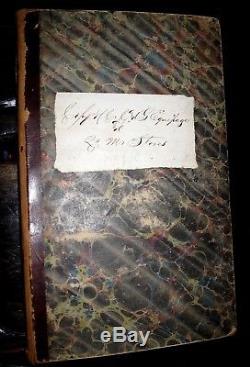

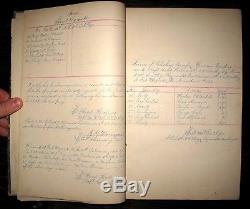
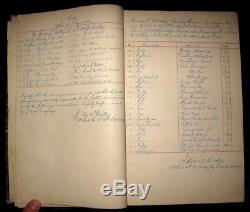
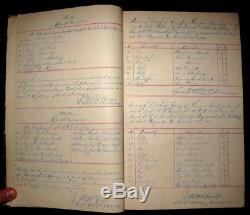


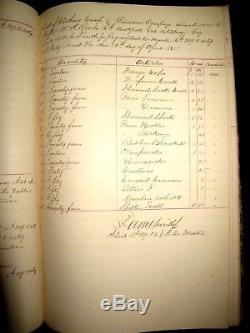



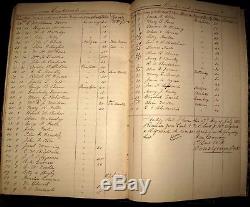


THE 16TH NY HEAVY ARTILLERY AND THE 10TH WEST VIRGINIA INFANTRY dated. MID-1 8 64 THROUGH JULY OF 1865. A RARE GLIMPSE INTO THE CIVIL WAR CAMP, INCLUDING LISTS/REQUISITIONS AND QUANTITIES OF EQUIPMENT, STORES, UNIFORMS, CAMP NEEDS AND GOODS, MUSICAL INSTRUMENTS, MILITARY ITEMS, TRANSPORTATION, AND MORE; QUITE HISTORIC, AS SOME ENTRIES VARIOUS LOCATIONS AND SOLDIER'S NAMES, AS WELL AS A LIST AT THE END OF CITIZENS WHO RECEIVED GOODS AS PART OF THEIR CONTRIBUTION FROM THE QUARTERMASTER! MOST OF THE LEDGER SEEMS TO BNE WRITTEN BY COLONEL J J MORRISON OF THE 16TH NY AND LATER PASSING OF LT. DAN CURRAN OF THE 10TH WVA, AND FINALLY BRIG GENERAL ANDISH DANCING MASTER EDWARD FERRERO (SEE BELOW).
SEE PICS FOR FURTHER DETAILS. Original and classic oblong ledger, marbled paper with leather spine and handwritten paper label to front, all intact the text being easy to read with many easily placed and well formatted entries. 100+ handwritten pages full of INFO, as shown.
GREAT PIECE OF CIVIL WAR UNION ARMY HISTORY! 16th New York Heavy Artillery Regiment. From Wikipedia, the free encyclopedia. 16th Regiment New York Heavy Artillery. September 1863 to August 21, 1865.
Battle of Chaffin's Farm. Battle of Darbytown and New Market Roads. Battle of Fair Oaks & Darbytown Road. Second Battle of Fort Fisher. The 16th New York Heavy Artillery Regiment was an artillery. During the American Civil War. But served mostly as infantry. Companies organized and mustered in between September 1863 and February 1864. All moved to Fortress Monroe.Regiment on duty at Fortress Monroe, Yorktown. Till June 1864, as Heavy Artillery and Infantry. Companies were attached to various brigades/divisions of X Corps. Through December 1864 and then XXII Corps.
The surplus men recruited were ordered transferred to the 6th New York Heavy Artillery Regiment. In April 1864, and in May 1864, a large number of men were transferred to the 81st New York Volunteer Infantry. And 148th New York Volunteer Infantry Regiment. And 270 to the 1st Regiment New York Mounted Rifles. Regiment concentrated at Washington, District of Columbia.July 1865, and duty there till August. Mustered out August 21, 1865.
According to one source in June 1864, the regiment was the largest regiment ever recruited in the United States, and has men in the following places: At Yorktown, 1,140; at Williamsburgh. 736; at Gloucester Point, 147; at Bermuda Hundred.
270; putting up telegraph, 60; with One Hundred and Forty-eighth New York Volunteers, 46; with First New York Mounted Rifles, 272transferred; with Eighty-fifth New York Volunteers. 46; with light batteries United States Artillery. 22; with Army of the Potomac.
201transferred; making a total of 2,928 men and 63 officers. This source claimed there were nearly 3,700 men mustered for the regiment. Regiment lost during service 42 Enlisted men killed and mortally wounded and 2 Officers and 284 Enlisted men by disease. 16th Artillery Regiment Civil War.
The following is taken from. New York in the War of the Rebellion. Mustered in by companies: September 1863 to February 2, 1864. Mustered out: August 21,1865. Morrison received authority, June 19, 1863, to recruit this regiment.
It was organized at New York city. The men enlisted for the Forster's Artillery formed part of it, and those enlisted for the 35th Battery were transferred to it as Company A, September 25, 1863.
The surplus men recruited were ordered transferred to the 6th N. Volunteer Artillery in April, 1864, and in May, 1864, a large number of men were transferred to the 81st and 148th N. Volunteer Infantry and 270 to the 1st Mounted Rifles. The companies were mustered in the service of the United States for three years; at Albany, A and B September 28; C and D October 21 and December 7, 1863, respectively; at Biker's island, E and G December 16, 1863, and January 9, 1864, respectively; at Elmira, F, H, I and K January 19, February 8, January 28 and February 2, 1864, respectively; at Auburn L and M January 26, 1864.
In July, 1864, a number of unassigned men were formed into a company designated N, but were gradually absorbed by Companies A, B, C, F, G and K, the battalion serving in the field with the 10th Corps under Majs. Strong and Fred'k W. They were recruited principally: A at Utica, New York city, Albany, Watertown, Ogdensburg, Albion and Rouse's Point; B at Albany. Little Falls, Poughkeepsie and New York city; C at Utica, Albany, Auburn, Rome, Watertown, Little Falls, Syracuse and Schenectady; D at Auburn, Utica, Canandaigua, Little Falls, Oswego, Schenectady, New York city, Elmira, Herkimer, Bath, Rome, Oswego and Buffalo; E at New York city, Brooklyn, Albany, Malone, Stuyvesant and Rome; F at Watertown, Canajoharie, Little Falls, Schenectady, Herkimer, Richfield, Norway, St.
Johnsville, Troy, Albany and Buffalo; G at New York city; H at Fort Edward, Syracuse, Canandaigua, Oppenheim, Schenectady, Canajoharie, Troy, St. Johnsville, Minden, Scott, Troy, Argyle and Kingsbury; I at Kingsbury, Granville, White Creek, Fort Ann, Fort Edward, Greenwich, Johnsburg, Hampton, Hebron, Easton and Utica; K at Poughkeepsie, Salem, Petersburg, White Creek, Cambridge, Hoosick, Easton, Stuyvesant, Greenwich, Troy, Pittstown, Chester and Weston; L at Fayette, Ira, Cato, Marcellus, Victory, Mentz, Elbridge, Skaneateles, Montezuma, Sterling, Covert, Auburn, Junius, Brutus, Romulus, Aurelius and Varick; and M at Auburn, Brutus, Victory, Sterling, Conquest, Fayette, Niles, Lodi, Cato, Sennett, Skaneateles, Montezuma and Elbridge. The regiment left the State by detachments: Companies A and B, October 14; Company C, October 22; Companies D and E, December 8 and 16, 1863, respectively; Company G, January 13, and the remaining companies later in January, 1864; it served as heavy artillery and infantry at Fort Monroe, Yorktown and Gloucester Point, Va.
Companies E and H in 1st Brigade, 3d Division, 10th Corps in July, 1864; Companies A, B, C, F, G, K and N in 2d Brigade, 1st Division, 10th Corps, from July 27, 1864; Company L, also from October, 1864; Companies A, B, C, F, G and K, in 2d Brigade, 1st Division, 24th Corps, and a detachment in the Artillery Brigade, 24th Corps, from December, 1864; Companies E and H in the Separate Brigade, Army of the James, at Fort Pocahontas, Va. From December, 1864; Companies A, B, C, F, G and K again in 2d Brigade, 1st Division, 10th Corps, from April.
When General Butler called for volunteers to commence the Dutch Gap canal, Companies A, B, C, F, G and K volunteered, and 600 men were selected from them for the work, and commenced it on the 9th of August, 1864; they were withdrawn August 19, 1864, but Major Strong continued in charge of the work, and Major Prince in command of the battalion. In July, 1865, the regiment was united; and, commanded by Colonel Morrison, it was honorably discharged and mustered out August 21, 1865, at Washington, D. Having lost by death, killed in action, 19 enlisted men; of wounds received in action, 24 enlisted men; of disease and other causes, 2 officers, 284 enlisted men; total, 2 officers, 327 enlisted men; aggregate, 329; of whom 4 enlisted men died in the hands of the enemy.
This regiment was recruited by T. Harris, who was a practicing physician at Glenville, Gilmer County, W. At the breaking out of the war.
At the solicitation of General Rosecrans, Dr. Harris visited governor Peirpoint at Wheeling in the latter part of July, 1861, and obtained his consent to recruit a regiment for the Union service with the understanding that in the event of his success in recruiting a regiment he should receive a commission as its colonel. He entered upon his work on the third day of August, 1861, and completed the organization of the 10th Regiment and received a colonels commission to command the same, about the 3d of May, 1862. The doctor had an extensive acquaintance with the country and the people and traveled over about 12 counties of the State, some of them several times, during the fall of 1861 and the winter of 1861-62, gathering recruits from the loyal purpose of hunting out suitable men for his line officers. In this work he used great discrimination and made very few mistakes.
The result was that his regiment, when organized, was under command of brave, intelligent and intensely loyal men. In this way its future good record was assured. The doctor found his task a tedious and difficult one. He found plenty of loyal people, but at that early period of the war they were laboring under the delusion that the war would be a short one and there would be enough of troops raised in the States North and West to put down the rebellion without their aid. He succeeded in getting four or five companies organized during the fall months of 1861, and these were put into service by the generals in command, at the request of the Governor, at points along the border line between the loyal and disloyal portions of the State, for the protection of the loyal people against guerilla raids. In this service they distinguished themselves as constituting a vigilant, intelligent and brave line of outposts. The service of this regiment after its organization in May, 1862, until June, 1864 was mostly in West Virginia. Having been recruited from the hardy mountaineers of the State, it was so particularly well adapted to the purpose of protecting the loyal interests against the enemy that the Governor was loth to give it up to any other service. It had the confidence of the loyal people who felt safe under its protection. In June, 1864, it was ordered to Martinsburg, and became incorporated into the organizations that were then being formed for operations against the enemys threatened advance down the Shenandoah Valley and was finally incorporated in the command known in army orders as the Army of West Virginia, under General Crook. At the close of the Valley campaign in December, 1864, it was sent, under the command of its former colonel, now commanding a division, to City Point, where it became incorporated with the 24th Army Corps and it served in this corps during the remainder of its term of service.This regiment was noted for its prowess, courage, intrepidity and general reliability. It participated in many hard fought engagements and always came out with a splendid record.
Most of its officers distinguished themselves for soldierly qualities and many of its private men won honorable mention. It was perhaps not excelled by any regiment in the service from this or any other State. Hall, 10th West Virginia Infantry. From the time that Colonel Harris was assigned to the command of a brigade, the command of the 10th Regiment devolved on its lieutenant-colonel, M. This officer was a native of Massachusetts who came to Virginia in 1845, being then 21 years old, and studied medicine with Dr.
Harris, who had married his sister. He had been engaged in the practice of medicine for several years and was living at Harrisville, in the County of Ritchie, when the war broke out. He was among the pioneer Republicans of the State and being of an ardent temperament and very patriotic, he engaged in recruiting a company for the loyal service in may, 1861, and had it ready for muster in on the 4th of July, 1861. His first commission was that of captain and he was assigned to the command of Company K of the Third Regiment.
This company had been recruited by him from the loyal men of his acquaintance, mostly from the county of Ritchie and for three years of service. He continued in command of this company until the organization of the 10th Regiment in May, 1862, when, at the solicitation of Colonel Harris, he was promoted to the lieutenant-colonelcy of the 10th. In this capacity he served until the expiration of the term of its enlistment. In every capacity in which he served, whether as line or field officer he distinguished himself for a loyal, intelligent, courageous and faithful discharge of duty. In every action in which his command was engaged, he won honorable mention.
He was twice wounded near Duffields Station; whilst engaged in resisting Earlys advance to enable General Sigels wagon train to cross the Potomac at Shepherdstown, he was struck by a minnie ball which broke the small bone of the forearm; and at Cedar Creek, on the 19th of October, he was again struck by a minnie ball which wold have passed through the liver had its course not been deflected by the yielding of a rib causing it to follow the rib in its course and emerge from the opposite side, thus being guided in its course and prevented from entering the cavity of the body. Colonel Hall will be remembered by his comrades in the service as long as they shall live for his personal as well his soldierly qualities. He was a brave, open-hearted, considerate and good officer. Organized at Camp Pickens, Canaan, Glenville, Clarksville, Sutton, Philippi and Piedmont March 12 to May 18, 1862. Attached to Cheat Mountain District, Mountain Department, to May, 1862.
Railroad District, Mountain Department, to July, 1862. Railroad District, 8th Corps, Middle Department, to September, 1862. Railroad Division, West Virginia, to January, 1863. 8th Army Corps, to February, 1863.2nd Brigade, 2nd Division, 8th Army Corps, to March, 1863. Averells 4th Separate Brigade, 8th Army Corps, Middle Department, to June, 1863. Averells 4th Separate Brigade, Dept. West Virginia, to December, 1863.
1st Brigade, 4th Division, West Virginia, to April, 1864. Kellys Command, Reserve Division, West Virginia, to July, 1864. 3rd Brigade, 1st Division; West Virginia, July, 1864.
1st Brigade, 1st Infantry Division, West Virginia, to December, 1864. 3rd Brigade, Independent Division, 24th Army Corps, Army of the James, to June, 1865. 2nd Brigade, Independent Division, 24th Army Corps, to August, 1865.
Assigned to railroad guard duty in Railroad District, District of West Virginia, till January, 1863; at Beverly, Bulltown, Martinsburg, etc. Expedition from Summersville to Addison April 17-21, 1862. Skirmish at Holly River, W. Scout to Beverly June 16.
Action at Beverly July 2-3. Averells Raid through Hardy, Pendleton, Bath, Highland, Greenbrier and Pocahontas Counties August 5-31.Rocky Gap near White Sulphur Springs August 26-27. Bells Mills and on Elk River August 27 (Detachment). Bulltown, Braxton County, October 13. Averells Raid against Lewisburg and the Virginia & Tennessee Railroad November 1-17. At Beverly till May, 1864; scouting Counties of Randolph, Tucker, Pocahontas, Greenbrier, Braxton, Highland, Pendleton and Webster.
Cheat River December 6, 1863. Moorefield Junction January 3, 1864. Scout from Beverly through Pocahontas, Webster and Braxton Counties May 15-30. Operations about Harpers Ferry July 10. Sheridans Shenandoah Valley Campaign August 6 to November 28.
Strasburg and Massanutton Mountain August 16. Battle of Opequan, Winchester, September 19. Battle of Cedar Creek October 19. Duty in Shenandoah Valley till December. December 19-20, thence to Bermuda Hundred December 20-23. Duty in the trenches north of James River till March, 1865. Appomattox Campaign March 28-April 9. Moved to front of Petersburg March 28-29.Hatchers Run March 30-31, and April 1. Assault on and fall of Petersburg April 2. Pursuit of Lee April 3-9. Appomattox Court House April 9. Surrender of Lee and his army.
March to Lynchburg April 12-15. March to Farmville and Burkesville April 15-19, thence to Richmond April 22-25. Duty near Richmond till August. Mustered out August 9, 1865. Compendium of the War of the Rebellion.Regiment lost during service 2 Officers and 93 Enlisted men killed and mortally wounded and 2 Officers and 144 Enlisted men by disease. (aged 68) New York City. Second Battle of Bull Run. Edward Ferrero (January 18, 1831 December 11, 1899) was one of the leading dance instructors, choreographers.
And ballroom operators in the United States. He also served as a Union Army. General in the American Civil War.
Most remembered for his dishonourable conduct in the Battle of the Crater. (July 1864), reported drinking with another general behind the lines, while both their units were virtually destroyed. Ferrero was born in Granada. His parents were natives of Italy. And had just arrived in Spain when their son was born.
Thirteen months later, the family moved to the United States and settled in New York City. Ferrero's father, a noted dancer and a personal friend of the revolutionary General Giuseppe Garibaldi. Soon opened a dance academy. When the elder Ferrero retired in his early fifties, Edward took over operation of the academy.
He educated the wealthy and elite of New York society in the art of dance, and originated many dances that spread in popularity throughout the country. Ferrero became renowned as one of America's leading experts in dance. He worked part-time as a dance instructor at the United States Military Academy.
And was the author of The Art of Dancing in 1859. Ferrero was interested in military affairs from his association as a youth with Garibaldi, and from his uncle, Colonel.
Lewis Ferrero, who had served in the Crimean War. Edward Ferrero became the lieutenant colonel. Of the 11th New York Militia Regiment, serving for six years in the militia.
With his skills in choreography and instruction, his troops soon became known for their parade ground precision and military drill. With the outbreak of the Civil War in early 1861, Ferrero raised a regiment.
At his own expense, the 51st New York Volunteer Infantry Regiment. He was commissioned as its first colonel. And drilled the regiment in military procedures.
Of three regiments in Maj. S expedition to Roanoke Island. Where his regiment seized the first fortified Confederate.
He also commanded a brigade at New Bern. Transferred northward with his brigade to Virginia. In the summer of 1862, he served in the army of Maj. During the Northern Virginia Campaign.Including the Second Battle of Bull Run. In September, he served at the battles of South Mountain. Where his brigade was a part of the Union IX Corps. And stormed Burnside's Bridge.
For his personal bravery at Antietam, the dancer-turned-warrior was promoted to brigadier general. Of volunteers on September 19, 1862.
This commission expired in March 1863, but he was reappointed to rank from May 6. The latter appointment was revoked on July 21, 1864. His first action as a general was at Fredericksburg. Sent to the Western Theater.
Along with the IX Corps in early 1863, Ferrero led his brigade with distinction during the Siege of Vicksburg. He subsequently commanded a division. And was in command of the defenses of Fort Sanders.
Transferred eastward again in 1864 with the corps, he served in the Siege of Petersburg. Commanding a division of black troops. His men were involved in the ill-fated July 30 charge on the Crater.
Where they suffered significant losses supporting the initial attack of Brig. Both Ferrero and Ledlie received criticism for remaining in a shelter behind the lines through most of the battle, passing a bottle of rum between them. A court of inquiry headed by Maj. Cited Ferrero for being in a bomb-proof habitually, where he could not see the operation of his troops [nor know] the position of two brigades of his division or whether they had taken Cemetery Hill or not. On December 2, 1864, Ferrero was breveted.For bravery and meritorious services. He served throughout the Appomattox Campaign. He chose not to reopen his previous dance academy, but instead leased a building in a new location, eventually turning it into a world-famed ballroom known as Apollo Hall. In 1872, he terminated his lease and the building was converted into a theater.
Ferrero leased the ballroom of Tammany Hall. For his academy and joined the Tammany Society.
Becoming socially active in Democratic. Political circles, although he never ran for office. He was active in veterans affairs, including the Grand Army of the Republic. He also joined the Freemasons.
He leased the Lenox Lyceum in January 1889 and continued as one of the country's foremost dance instructors for another decade. He retired in May 1899 when he became ill with a variety of ailments that claimed his life by the end of the year.
Ferrero died in New York City and is buried in Green-Wood Cemetery. The Art of Dancing Historically Illustrated to Which is Added a Few Hints on Etiquette ISBN. The History of Dancing ISBN.The item "1863-65 CIVIL WAR Ledger 16th NY ARTILLERY 10th WVA Union GOODS Stores NAMES" is in sale since Friday, May 04, 2018. This item is in the category "Books\Antiquarian & Collectible". The seller is "mantosilver" and is located in Spencerport, New York.
This item can be shipped worldwide.
- Binding: Leather
- Subject: Military & War
- Special Attributes: Signed
- Origin: American
- Year Printed: 1863
- Topic: Civil War (1861-65)

